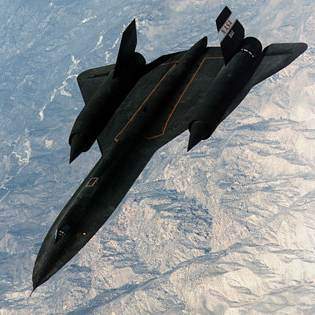The Blackbird, code-named Oxcart during its development, flies on a tremendous 65,000 lbs. of thrust at an altitude of 100,000+ feet at Mach 3.5, and has a range of four thousand miles. That is not only four times faster than the U-2 but seven miles higher - and the U-2 was then the current high-altitude champion.

|
For a long time the Air Force claimed a maximum speed of Mach 3.2 and an operational ceiling of 85,000 feet, but we now know that the SR-71 can soar above 100,000 feet. Some military pilots claim altitudes in excess of 125,000 feet but this is probably stretching it a bit. Compared to the fastest jet fighter America had at the time, the SR-71 flew at least 60 percent faster than its maximum speed on afterburner.
Experimental rocket engines had flown this fast for only two or three minutes at a time before running out of fuel. But the Blackbird can cruise at more than three times the speed of sound, and fly coast to coast in less than an hour on one tank of gas. The aircraft can also survey more than 100,000 square miles of the Earth's surface in one hour. The Blackbird actually stretches a few inches during flight, due to the massive temperatures on its titanium hull. To many, the Blackbird is the epitome of grace and power, not to mention blinding speed.
The SR-71 has seen much controversial debate over its true situation within the Air Force. On 6 March, 1990, the legendary SR-71 Blackbird was retired after Blackbird (serial number 64-17972) shattered the official air speed record from Los Angeles to Washington's Dulles Airport. The sudden decommissioning of the aircraft with little opposition from the USAF stirred controversy over the possibility of a successor aircraft, the alleged Aurora.
As of 1st January 1997, two SR-71 air crews and planes were declared mission ready for the first time since the plane's retirement, seven years ago. In 1994, Congress appropriated funds to put two aircraft back into service, and these airplanes were taken out of storage, refurbished, and delivered to the USAF. (One was located at NASA's Dryden research facility and the other at the Skunk Works.) These two Blackbirds and their crews are now based at Edwards Air Force Base, though administratively, they are part of the 9th Recon Wing at Beale. These SR-71s are equipped with reconnaissance sensors, including the Advanced Synthetic Aperture Radar system that provides near real-time, all-weather, day or night imagery.
Official reports said the supersonic spyplane was being retired to save the $200-300 million annual cost to operate the fleet in favor of advanced satellite systems. However, background research and reports suggest that it was no longer the zenith of the reconnaissance community. Reports of a highly-advanced hypersonic spyplane were growing every year. It wasn't until 1 July, 1994 when the Senate Appropriation's Committee added $100 million in funding to bring the three SR-71s back into operation that rumor speculated the alleged hypersonic spyplane Aurora may be suffering problems.
However, this was not the end of the story. In January 1995, Popular Science published an article about a "revisionist Aurora". The A-17 Northrop stealth attack aircraft came to light. It is thought by many that the A-17 was actually the aircraft that was allegedly seen in formation by Chris Gibson over the North Sea in August 1989.